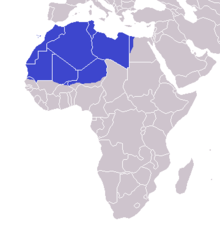Tamazgha

Tamazgha (Berber languages: Tamazɣa, Tifinagh: ⵜⴰⵎⴰⵣⵗⴰ or ⵜⴰⵎⴰⵣⵖⴰ) is a Berber language toponym denoting the Greater Maghreb, the lands traditionally inhabited by Berbers (Mazice/Amazigh). The region encompasses the geographical area between the Mediterranean Sea and the Niger River, a large swathe of territory spanning Morocco, Algeria, Tunisia, Libya, Mali, Niger, Egypt and the Canary Islands.[1]
Although the Berber linguistic root MZƔ or ZƔ is ancient, Tamazɣa as a toponym is derived from the Berber language, coined in the context of Berber nationalism. It appeared for the first time in Algeria and Morocco in the 1970s. It is not clear at all who coined it. Some say it was Mouloud Mammeri (1917–1989). According to others, it was Kateb Yacine (1929–1989).
The most inhabited areas of the Tamazgha are the coastal fertile regions of northern Libya, northern and eastern Tunisia, northern Algeria, northern Morocco, and the Atlantic coast of Morocco. "Tamazgha" corresponds roughly to Herodotus' Ancient Libya and to the medieval Barbary Coast.
The term is used by the Berbers because there was not originally a common word that refers to all the geographical territory inhabited by the Mazices, since the Mazice people live in several countries, and they are not united politically, with many scattered around the World by the Mazice Diaspora. So, the name has been created to define an Mazice Nation, and unify the people of the Tamazgha, or the Great Maghreb with their original culture. Many philologists sort this term like neologism, built from traditional Berber (Tamazight) terms.
The term has been translated into Spanish as Mazigia, abbreviated as MZG and used as an alternative international license plate code for some people .
Notes
- ↑ Hurst Hannum, Eileen Babbitt (eds.) (2006). Negotiating Self-determination. Lexington Books. p. 135. ISBN 0739114336. Retrieved 3 April 2017.